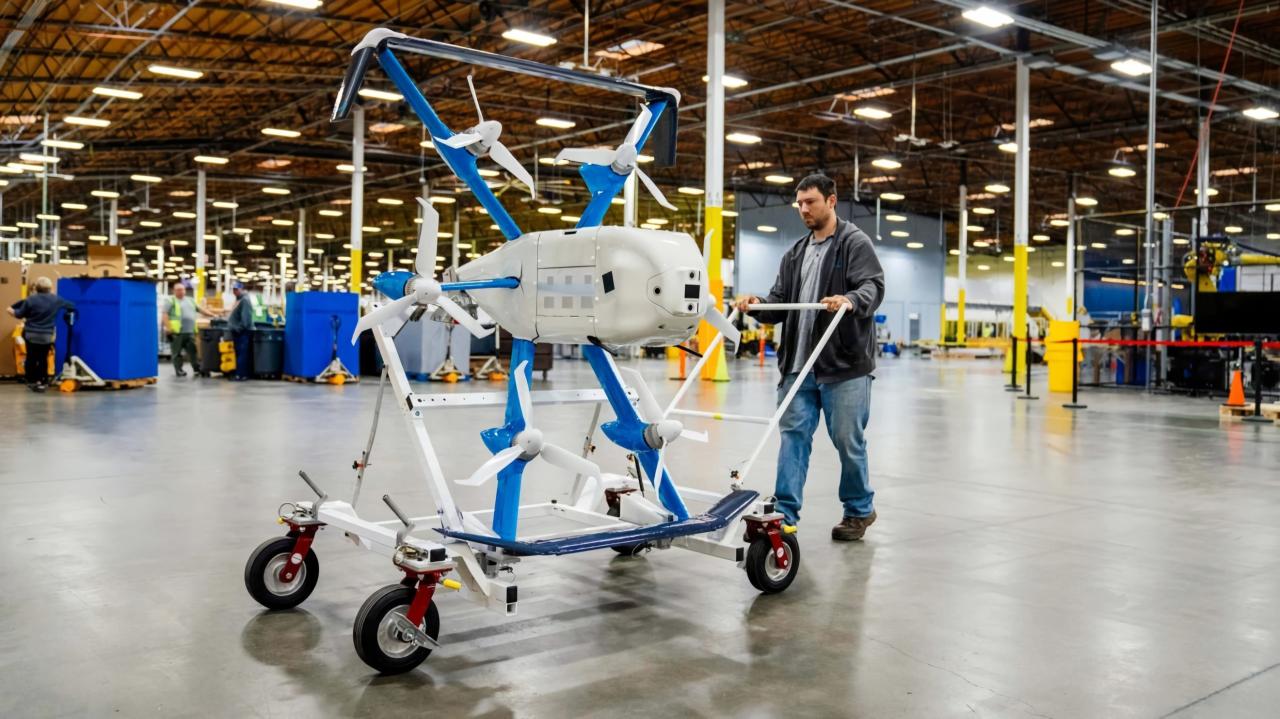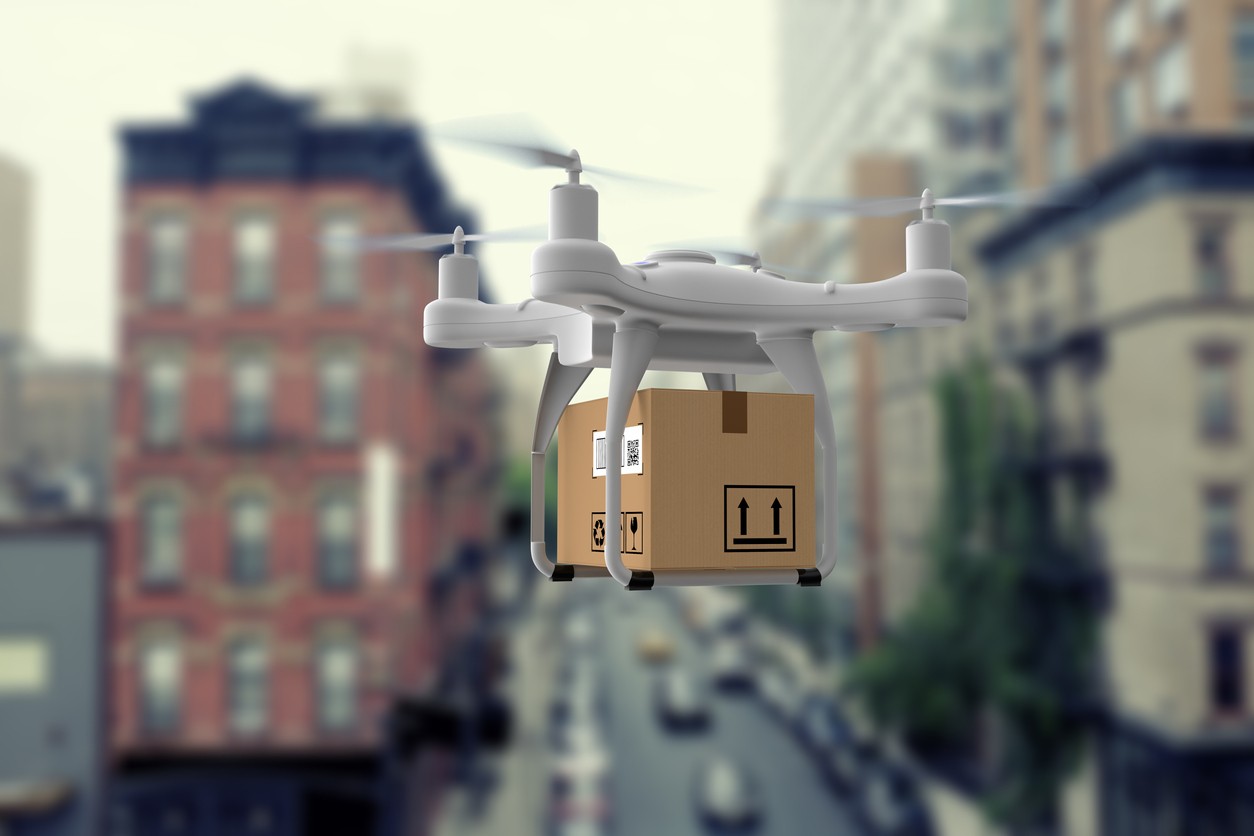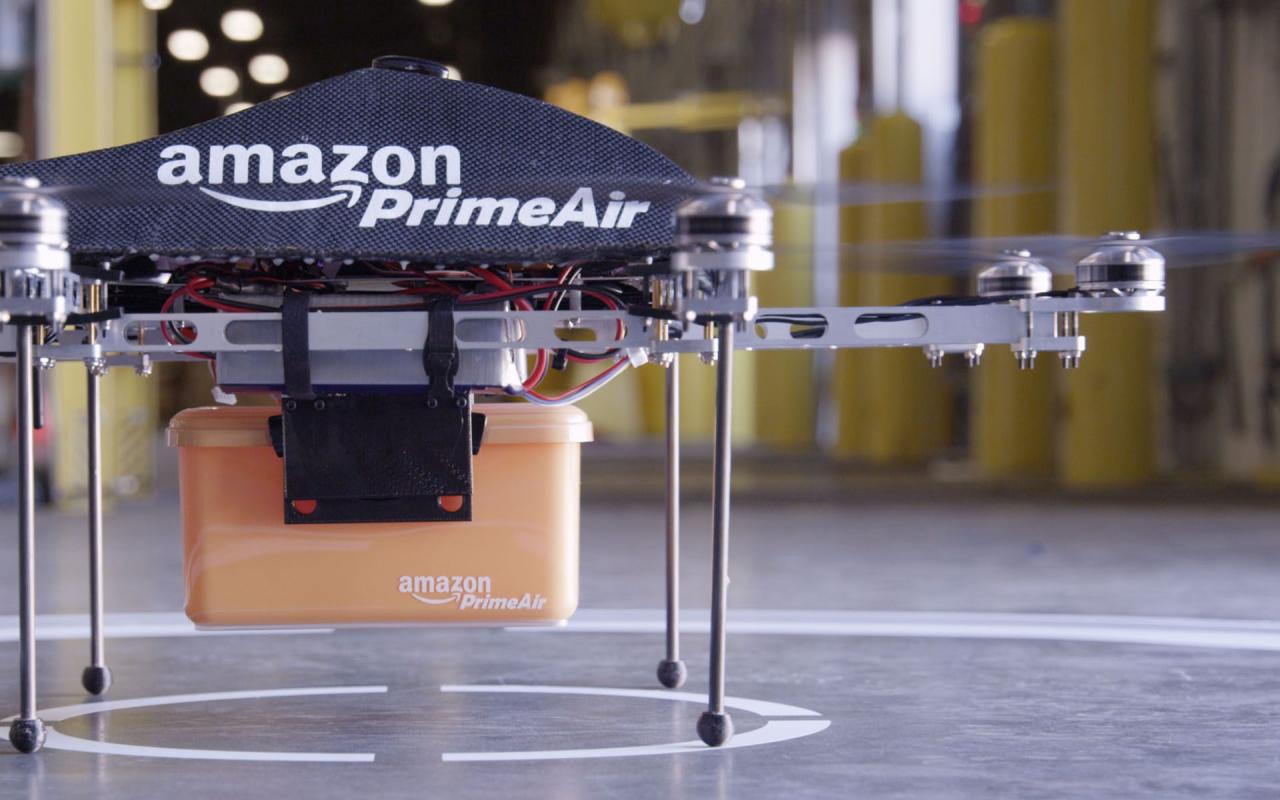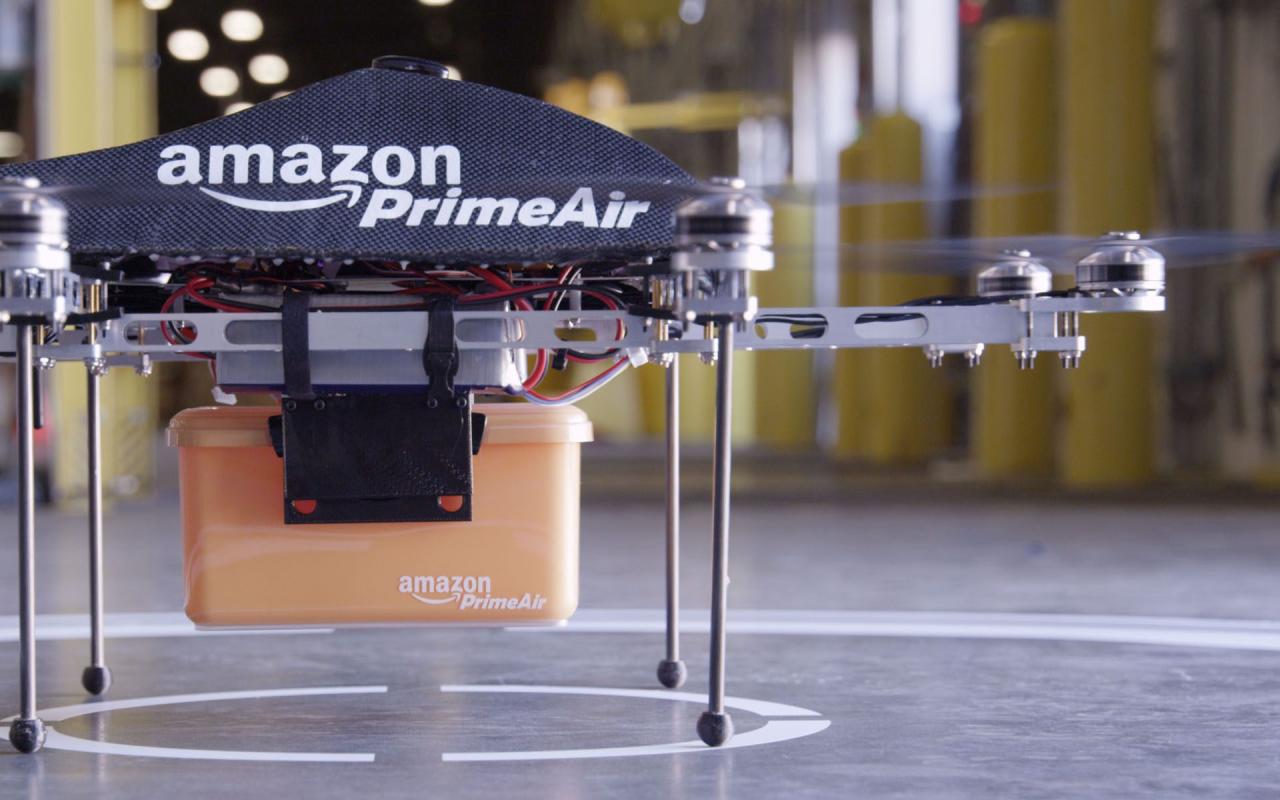Amazon drone delivery locations are rapidly expanding, revolutionizing how we receive packages. This isn’t just about faster delivery; it’s about reshaping logistics, impacting communities, and pushing the boundaries of technology. We’ll explore where Amazon’s drones currently fly, the factors influencing location selection, future expansion plans, and the broader economic and social implications of this innovative delivery method.
From the technological infrastructure supporting these aerial deliveries to the regulatory hurdles Amazon faces, we’ll delve into the complexities and exciting potential of drone delivery. Understanding the challenges and successes is key to appreciating the transformative power of this rapidly evolving system. We’ll also look at how factors like population density, airspace regulations, and technological advancements shape the landscape of Amazon’s drone delivery network.
Current Amazon Drone Delivery Program Status
Amazon’s drone delivery program, officially known as Amazon Prime Air, is steadily expanding its reach and capabilities, though it’s still in a relatively early stage of deployment compared to its initial ambitious projections. While not yet a ubiquitous service, it represents a significant step towards faster and more efficient delivery methods.Amazon Prime Air’s current operational scope is limited to specific geographic areas in the United States.
The service isn’t available nationwide, and even within operational areas, service is not guaranteed to every address. Expansion is gradual and depends on factors like regulatory approvals, infrastructure development, and public acceptance.
So you’re curious about Amazon drone delivery locations? They’re expanding rapidly, but it’s still pretty limited. Think about how that contrasts with the recent news about a mystery drone in Paris , which highlights how drone technology is evolving globally. Getting back to Amazon, keep an eye on their website for updates on where they’re currently offering drone delivery – it’s changing fast!
Geographical Scope of Amazon Drone Delivery
Currently, Amazon Prime Air operates in select locations across several states in the United States. These areas are carefully chosen based on factors such as population density, airspace regulations, and existing infrastructure. The company strategically expands into new regions as it gains experience and secures the necessary approvals and technological advancements. The exact locations are not always publicly available, but generally involve smaller towns and suburban areas that are better suited for initial drone delivery operations.
The program avoids densely populated urban areas with complex airspace and regulatory hurdles.
Types of Goods Eligible for Drone Delivery
The range of products available for drone delivery is limited. Currently, Amazon primarily focuses on smaller, lighter packages that can be safely and efficiently transported by their drones. These often include everyday items, such as books, electronics, and other consumer goods that fit within the weight and size restrictions of the drones. Larger or heavier items, fragile goods, and perishable items are generally excluded.
Amazon continually evaluates and expands the eligible product categories as its technology improves and safety protocols are refined.
So you’re curious about where Amazon’s delivering packages via drone, huh? It’s pretty cool tech! To get the lowdown on exactly which areas are currently seeing those nifty drone deliveries, check out this helpful resource: amazon drone delivery locations. Knowing these locations helps you understand the expansion of this exciting delivery method and maybe even see if it’s coming to your neighborhood soon!
Technological Infrastructure Supporting Amazon’s Drone Delivery Network
Amazon’s drone delivery system relies on a complex interplay of technologies. This includes a fleet of autonomous drones equipped with advanced sensors, GPS, and collision-avoidance systems. These drones operate within a sophisticated network of ground control stations, which monitor and manage the drones’ flights, ensuring safety and efficiency. The company also utilizes proprietary software and algorithms for flight planning, route optimization, and package delivery management.
Furthermore, integration with existing Amazon logistics networks is crucial for efficient order processing and package handling before and after drone delivery. This integration involves sophisticated tracking and management systems to ensure seamless transition between traditional delivery methods and drone delivery.
Timeline of Significant Milestones in Amazon Drone Delivery
The development and deployment of Amazon Prime Air has involved several significant milestones. Early testing and development began years ago, involving numerous iterations of drone designs and software. Subsequent milestones include obtaining FAA certifications and approvals, which are crucial for legal and safe operation. The launch of limited operational areas marked a key step toward commercial deployment.
Continued progress involves expanding the operational area, improving drone technology, and refining delivery processes. While a precise timeline of all milestones is not publicly available, these general phases represent the key steps in Amazon’s ongoing development of drone delivery.
Factors Influencing Drone Delivery Location Selection

Amazon’s selection of locations for its drone delivery program is a complex process, balancing technological capabilities with logistical and regulatory realities. The aim is to identify areas where drone delivery offers a clear advantage over traditional methods, maximizing efficiency and minimizing risk. Several key factors play a crucial role in this decision-making process.
Population Density and Delivery Demand
Population density is a significant factor influencing location selection. High-density areas, like suburbs or smaller cities, often present a higher volume of potential deliveries, making drone deployment economically viable. However, extremely high-density urban centers present unique challenges (discussed later). Amazon likely prioritizes areas with a sufficient population density to justify the operational costs of drone delivery infrastructure, while also considering the distribution of that population to ensure efficient flight paths and delivery coverage.
For example, a suburban area with a relatively even distribution of homes might be more suitable than a densely packed urban core with numerous tall buildings and narrow streets.
Infrastructure and Airspace Regulations
The existing infrastructure significantly impacts location suitability. This includes aspects like airspace regulations, the presence of controlled airspace (near airports, for example), and the availability of suitable drone landing zones. Areas with well-established, less congested airspace, and minimal obstacles (tall buildings, power lines) are preferred. Robust road networks are also important for supporting ground-based operations, such as retrieving drones after delivery or addressing any unforeseen issues.
Amazon needs reliable ground infrastructure to support its drone fleet’s operations, especially in terms of maintenance and emergency response. Areas with limited road access might pose challenges for effective drone deployment. For instance, a location with restricted airspace due to a nearby airport might be less favorable than a location with open airspace and easily accessible landing zones.
Urban versus Rural Drone Delivery Challenges
Implementing drone delivery presents contrasting challenges in urban and rural environments. Urban areas pose complexities due to high population density, congested airspace, and the presence of numerous obstacles. Navigating intricate airspace and ensuring safe delivery in close proximity to buildings and people requires advanced technology and sophisticated flight planning. In contrast, rural areas may have less congested airspace, but the dispersed population can lead to longer flight times and higher operational costs per delivery.
Delivering to isolated rural homes might require extensive flight distances, which reduces the economic viability of drone delivery unless the distance is offset by the absence of alternative delivery options. Furthermore, the lack of readily available infrastructure for maintenance and support in remote areas also needs careful consideration.
Future Expansion Plans for Drone Delivery Locations

Amazon’s drone delivery program, while still in its relatively early stages, shows immense potential for expansion. The current operational areas serve as crucial testing grounds, providing valuable data on efficiency, logistical challenges, and regulatory compliance. This data informs a strategic expansion plan focusing on areas with high population density, robust infrastructure, and supportive regulatory environments.
Potential Future Expansion Areas
Predicting future expansion requires considering factors like population density, existing infrastructure (suitable for drone operations and package handling), regulatory frameworks, and the presence of existing Amazon fulfillment centers. Areas with high e-commerce penetration and a demand for faster delivery options are prime candidates. We can expect Amazon to prioritize regions where they already have a strong logistical footprint.
For example, areas around major metropolitan areas in the US, particularly those with less restrictive airspace regulations, are likely targets. Similarly, expanding into other developed countries with similar characteristics, such as parts of Europe and Asia with advanced drone technology acceptance and relatively less-stringent regulations, seems plausible. Expanding into less developed regions will likely be a later phase due to the need for more robust infrastructure and potentially more complex regulatory approvals.
Hypothetical Expansion Plan
A phased approach is essential for successful expansion. Phase 1 would involve focusing on replicating successful models from existing operational areas. This involves identifying geographically similar areas with compatible regulatory landscapes and focusing on smaller, manageable expansion zones. Phase 2 would involve scaling operations within existing regions by adding more drone hubs and expanding delivery ranges. Phase 3 would involve expanding into new countries, requiring significant investment in infrastructure, regulatory compliance, and localized partnerships.
This plan acknowledges the significant logistical hurdles, including establishing new drone hubs, obtaining necessary airspace permissions, and managing the complexities of international regulations. Overcoming regulatory hurdles necessitates proactive engagement with aviation authorities, demonstrating safety protocols, and addressing public concerns regarding noise and privacy.
Strategies to Accelerate Growth
Several strategies can accelerate growth. Firstly, strategic partnerships with local businesses and governments are crucial to streamline regulatory processes and build local support. Secondly, investing in advanced drone technology, such as autonomous navigation and improved battery technology, will increase efficiency and range. Thirdly, developing robust and reliable drone maintenance and repair networks is critical to minimizing downtime and ensuring operational consistency.
Finally, public education campaigns addressing safety concerns and highlighting the benefits of drone delivery can help build acceptance and reduce regulatory resistance. Amazon’s experience with Prime Air already provides a solid foundation for addressing these challenges. They’ve shown a willingness to invest heavily in R&D and navigate complex regulatory landscapes.
Projected Future Drone Delivery Locations
| Region | Country/State | City/Area | Projected Launch Date |
|---|---|---|---|
| North America | United States | Dallas-Fort Worth Metroplex | 2024 Q4 |
| Europe | United Kingdom | Greater London Area | 2025 Q2 |
| Asia | Japan | Tokyo Metropolitan Area | 2026 Q1 |
| North America | Canada | Toronto | 2025 Q3 |
Economic and Social Impacts of Drone Delivery Locations
Drone delivery’s expansion promises significant economic and social shifts in chosen locations. The integration of this technology will reshape business models, consumer experiences, and community dynamics, presenting both opportunities and challenges. Understanding these impacts is crucial for successful implementation and mitigation of potential negative consequences.
Economic Benefits of Drone Delivery, Amazon drone delivery locations
The economic benefits of drone delivery are multifaceted. For businesses, drones offer cost reductions in last-mile delivery, a traditionally expensive aspect of logistics. Faster delivery times translate to increased customer satisfaction and potentially higher sales. Smaller businesses, especially those in rural areas with limited access to traditional delivery networks, could see a significant boost in their reach and competitiveness.
Consumers benefit from faster and potentially cheaper delivery options, leading to increased convenience and access to goods. For example, a rural pharmacy could use drones to deliver urgently needed medications, while an online retailer could offer same-day delivery to a wider customer base. This efficiency translates to economic gains for both businesses and consumers.
Social Impacts on Employment and Community Infrastructure
The introduction of drone delivery will inevitably impact employment. While some jobs in traditional delivery services might be displaced, new opportunities will emerge in drone maintenance, operation, and related technologies. The creation of specialized drone delivery hubs could stimulate local economic activity, creating jobs in areas like logistics management and drone pilot training. However, careful planning is needed to ensure a smooth transition and to address potential job displacement through retraining programs and support for affected workers.
Furthermore, the infrastructure needed to support drone delivery, such as charging stations and maintenance facilities, could lead to improvements in local infrastructure.
Environmental Impacts of Increased Drone Delivery
The environmental impact of increased drone delivery is a complex issue with both positive and negative aspects.
- Positive Impacts: Reduced reliance on ground transportation could lead to lower carbon emissions, especially in urban areas plagued by traffic congestion. Drones, particularly electric ones, could contribute to cleaner air in densely populated areas. Optimized delivery routes could also minimize fuel consumption.
- Negative Impacts: Increased drone operations could lead to higher noise pollution, especially in residential areas. The manufacturing and disposal of drones contribute to electronic waste. Battery production and disposal also raise environmental concerns. Increased air traffic from drones may also impact wildlife, particularly birds.
Impact on Local Transportation Networks and Traffic Congestion
Drone delivery has the potential to significantly impact local transportation networks. By moving some delivery traffic from roads to the air, it could alleviate congestion in urban areas, particularly during peak hours. This could lead to reduced travel times for both ground vehicles and drones. However, the integration of drones into existing airspace needs careful management to ensure safety and avoid conflicts with other air traffic, including manned aircraft.
Regulations and infrastructure, such as designated drone corridors, are necessary to manage the increased air traffic efficiently and safely. For instance, cities like Los Angeles, known for significant traffic congestion, could see a noticeable improvement in traffic flow if a significant portion of last-mile deliveries were shifted to drones.
Regulatory and Safety Aspects of Drone Delivery Locations

Amazon’s expansion of drone delivery faces a complex regulatory landscape and necessitates stringent safety protocols. Successfully navigating these challenges is crucial for the program’s viability and public acceptance. This section details the key regulatory hurdles, safety measures, permitting processes, and privacy considerations involved.
Key Regulatory Hurdles for Amazon Drone Delivery
Expanding drone delivery operations requires Amazon to comply with a patchwork of federal, state, and local regulations. These regulations vary widely across jurisdictions, creating significant challenges for nationwide operations. Major hurdles include airspace restrictions (particularly near airports and other sensitive areas), weight and distance limitations on drone payloads, and requirements for pilot certification and drone registration. For example, obtaining waivers for Beyond Visual Line of Sight (BVLOS) operations, which are essential for efficient drone delivery networks, often involves lengthy and complex application processes with different requirements in each location.
Furthermore, integrating drone traffic management systems into existing air traffic control infrastructure presents a significant technological and regulatory hurdle.
Safety Protocols and Measures for Safe Drone Operations
Amazon implements a multi-layered approach to ensure the safety of its drone operations. This includes rigorous testing and maintenance of drones, sophisticated flight control systems with redundancy features to prevent crashes, and real-time monitoring of drone flights using advanced sensor technology. Obstacle avoidance systems using sensors like lidar and radar are crucial for navigating complex urban environments. Detailed flight planning and simulation are employed to identify and mitigate potential risks before each flight.
So, Amazon’s expanding its drone delivery locations, aiming for quicker, more efficient service. However, safety is key, and recent news about drone crashes in Paris highlights the challenges of widespread drone use. This underscores the need for robust safety protocols as Amazon continues to roll out its drone delivery network to new areas.
Furthermore, Amazon utilizes geofencing technology to restrict drone flights to pre-approved areas, preventing accidental incursions into restricted airspace or populated zones. In the event of a malfunction, automated emergency landing procedures are in place. Regular safety audits and reviews ensure continuous improvement of safety protocols.
Process for Obtaining Permits and Approvals for Drone Delivery
Securing the necessary permits and approvals for drone delivery is a multi-step process that varies by location. It generally involves applications to the Federal Aviation Administration (FAA) for airspace authorizations, certificates of authorization (COAs) for specific flight operations, and waivers for BVLOS operations. State and local authorities may also impose additional requirements, such as land-use permits or environmental impact assessments.
The application process can be lengthy and involves detailed documentation demonstrating compliance with all relevant regulations and safety standards. Amazon often collaborates with local governments and regulatory bodies to streamline the approval process and ensure smooth integration of drone delivery into the community. Successful applicants are then issued permits allowing operation within specified parameters.
Addressing Privacy and Data Security Concerns
Addressing privacy concerns related to drone delivery is paramount. Amazon employs data encryption and secure data storage protocols to protect the privacy of customer information collected during drone operations. Drones are equipped with cameras for navigation and delivery confirmation, but the use of this imagery is strictly regulated and limited to operational purposes. Transparency regarding data collection practices and the implementation of robust data security measures are critical for building public trust and compliance with privacy regulations such as GDPR and CCPA.
Amazon’s commitment to responsible data handling is a key factor in gaining public acceptance of drone delivery.
Technological Advancements and Their Impact on Drone Delivery Locations: Amazon Drone Delivery Locations

Technological advancements are rapidly reshaping the landscape of Amazon’s drone delivery program, significantly impacting the feasibility and scope of its operations. Improvements in several key areas are expanding the reach and capabilities of drone delivery, leading to a wider range of potential delivery locations and services.
Battery Technology and Drone Range
Advancements in battery technology are crucial for extending the operational range of delivery drones. Larger battery capacities, coupled with increased energy efficiency, allow drones to travel further distances on a single charge. This directly translates to a wider service area, making drone delivery viable in more geographically dispersed locations, including rural areas previously inaccessible due to limited range. For example, the shift from lithium-ion polymer batteries to potentially higher-capacity solid-state batteries could dramatically increase flight time and range, allowing drones to cover significantly larger areas.
This expansion reduces reliance on strategically located drone hubs and opens up new delivery zones.
Improved Drone Navigation and Autonomous Flight Systems
Sophisticated navigation systems and autonomous flight capabilities are paramount for safe and efficient drone operations. Real-time obstacle avoidance, precise GPS tracking, and advanced flight planning algorithms enhance the reliability and safety of deliveries. This improved autonomy allows drones to navigate complex urban environments and reach more challenging delivery locations, including those with limited infrastructure or restricted airspace. For instance, the incorporation of advanced sensor fusion (combining data from multiple sensors like cameras, lidar, and radar) allows drones to make more informed decisions in unpredictable conditions, improving both safety and efficiency.
This directly leads to increased accessibility of delivery locations, even in challenging terrains or congested urban areas.
Drone Payload Capacity and Goods Delivered
Increased drone payload capacity allows for the delivery of a wider variety of goods. Larger drones capable of carrying heavier packages open up possibilities for delivering larger items, multiple packages at once, or even temperature-sensitive goods requiring specialized containers. This expansion in payload capabilities transforms drone delivery from a niche service for small packages to a more versatile solution capable of handling a larger portion of the e-commerce market.
For example, the ability to deliver groceries or larger household items significantly increases the practicality and appeal of drone delivery for consumers. This expands the types of goods delivered and the overall customer base.
Evolution of Amazon Drone Technology and its Impact on Delivery Locations
Imagine a timeline illustrating Amazon’s drone delivery evolution. The earliest iterations are depicted as small, relatively short-range drones with limited payload capacity, suitable only for delivering small packages to highly accessible locations. The next stage shows a gradual increase in size and range, incorporating improved battery technology and more sophisticated navigation systems. These drones can reach more dispersed locations, expanding the service area.
Finally, the most advanced drones are depicted as larger, longer-range aircraft with significant payload capacity, capable of navigating complex environments and delivering a wide variety of goods to a vastly expanded range of delivery locations – encompassing rural and suburban areas, and even expanding into more densely populated urban centers with intricate airspace management systems. This visual representation showcases the exponential growth in capabilities, directly correlating to the broadening accessibility of drone delivery locations.
Last Point
Amazon’s drone delivery program represents a significant leap forward in logistics and technology. While challenges remain, the potential benefits—from faster delivery times and reduced congestion to economic growth in underserved areas—are undeniable. As technology continues to advance and regulations adapt, we can expect to see Amazon’s drone network expand significantly, transforming the way we receive goods in the years to come.
The future of delivery is taking flight.
Essential FAQs
What types of packages can be delivered via Amazon drones?
Currently, Amazon’s drone delivery program focuses on smaller, lighter packages. The exact weight and size limits vary depending on the drone model and location.
How does Amazon ensure the safety of drone deliveries?
Amazon employs sophisticated safety protocols, including advanced sensor technology, redundant systems, and rigorous pilot training. They also work closely with regulatory bodies to ensure compliance with safety regulations.
What about privacy concerns related to drone delivery?
Amazon uses technology that protects customer privacy. Drones are typically equipped with cameras for navigation purposes only, and data is handled securely according to privacy regulations.
Are there any environmental impacts associated with drone deliveries?
While drones offer some environmental benefits (like reduced truck traffic), their impact is complex. Factors like battery production and potential noise pollution need to be considered and mitigated.
